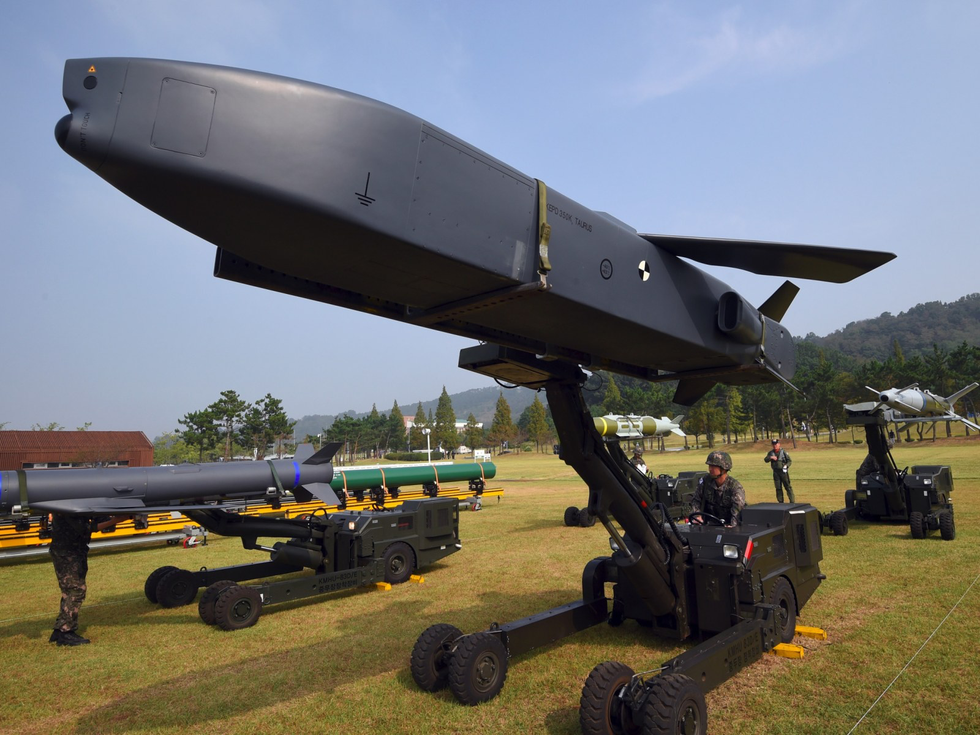
About Taurus Missile:
- It is a German-origin precision-guided, long-range air-to-surface cruise missile.
- This missile was developed in the mid-1990s as a joint effort between the German company LFK (now MBDA Deutschland) and the Swedish company Saab Bofors Dynamics.
- It is capable of precision strikes on stationary and semi-stationary targets.
- Features:
- Weighing in at 1,400 kg and measuring approximately 5.1 meters in length, this versatile missile can be deployed from a variety of platforms Powered by a turbofan engine, the missile achieves subsonic speeds with impressive fuel efficiency.
- It features a dual-stage warhead known as MEPHISTO, which is specifically designed to penetrate hardened bunkers and underground facilities before detonation.
- It flies at an altitude of only 35 meters, which makes it almost impossible for radar systems to detect.
- Range: 500 km
- The missile’s guidance system merges GPS, INS (Inertial Navigation System), and TERCOM (Terrain Contour Matching) technologies, guaranteeing unerring precision even in GPS-denied environments.
- It's low radar cross-section and advanced defense mechanisms protect it against interception and neutralization attempts.
2. What is Arthritis?
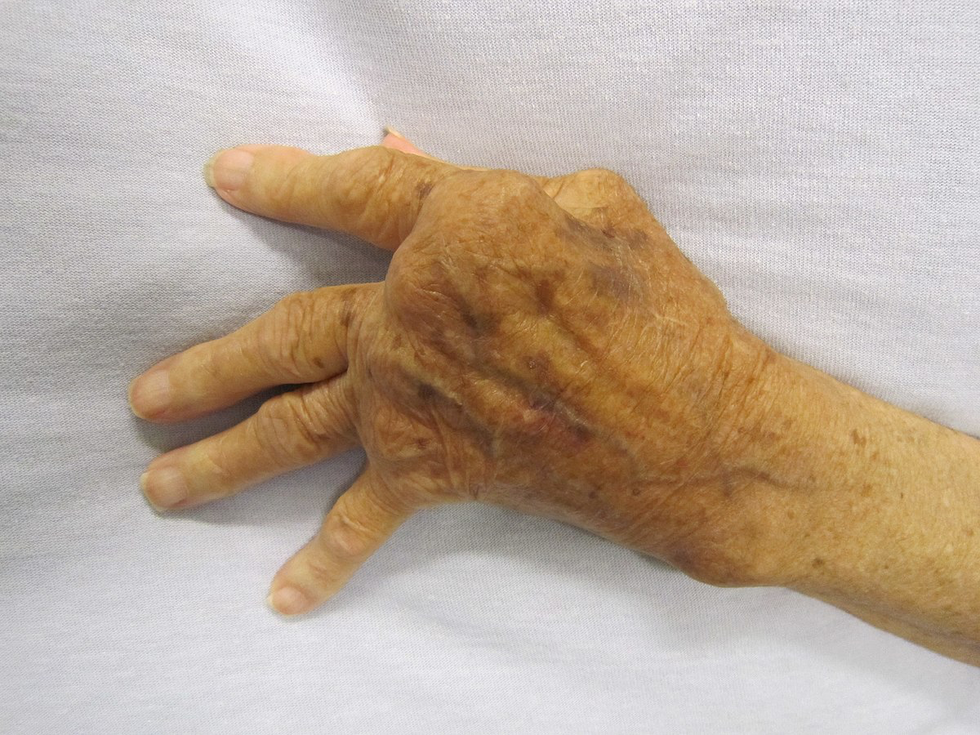
About Arthritis:
- Arthritis is inflammation or degeneration of one or more joints.
- A joint is the area where 2 bones meet.
- There are more than 100 different types of arthritis.
- Causes:
- Arthritis involves the breakdown of structures of the joint, particularly cartilage.
- Normal cartilage protects a joint and allows it to move smoothly.
- Cartilage also absorbs shock when pressure is placed on the joint, such as when you walk.
- Without the normal amount of cartilage, the bones under the cartilage become damaged and rub together.
- This causes swelling (inflammation), and stiffness.
- The most common types of arthritis are osteoarthritis and rheumatoid arthritis.
- Osteoarthritis causes cartilage — the hard, slippery tissue that covers the ends of bones where they form a joint — to break down.
- Rheumatoid arthritis is a disease in which the immune system attacks the joints, beginning with the lining of joints.
- Treatment: Treatments vary depending on the type of arthritis. The main goals of arthritis treatments are to reduce symptoms and improve quality of life.
3. Tadoba-Andhari Tiger Reserve
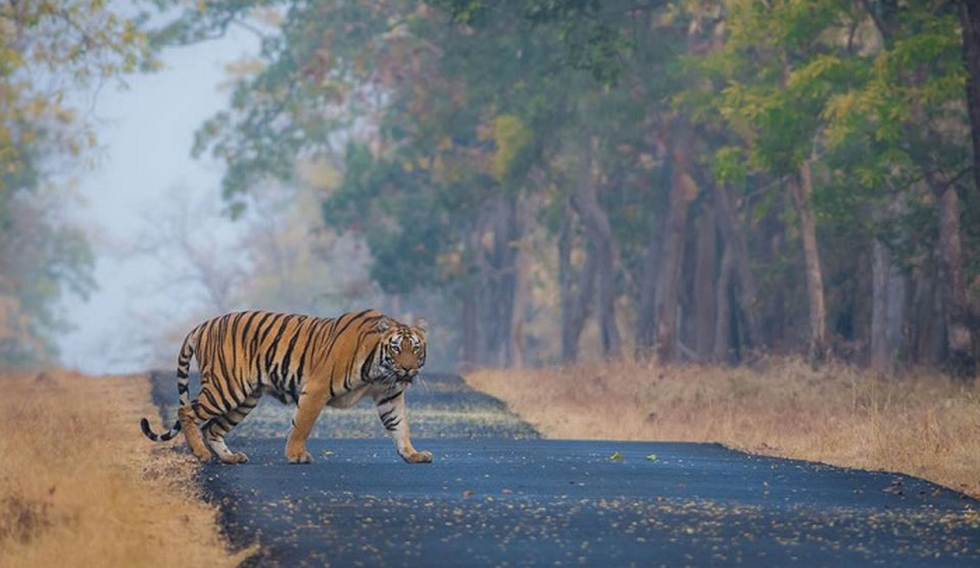
About Tadoba-Andhari Tiger Reserve:
- Location: It is located in the Chandrapur district in Maharashtra.
- It is the largest and oldest Tiger Reserve of Maharashtra.
- The origin of the name "Tadoba" lies with the name of the god "Tadoba" or "Taru", worshipped by the tribes that live in the dense forests of the Tadoba and Andhari regions. "Andhari" refers to the Andhari River that meanders through the forest.
- The total area of the reserve is 625.4 sq. km. This includes Tadoba National Park, covering 116.55 sq. km, and Andhari Wildlife Sanctuary, covering 508.85 sq. km.
- Corridor: The reserve has corridor linkages with Nagzira-Navegaon and Pench Tiger Reserves within the State.
Habitat:
- Biogeographically, the reserve falls in the Central Plateau province of the Deccan Peninsula.
- The habitat has undulating topography in the north and is rich in biodiversity.
- Vegetation: Southern Tropical Dry Deciduous
- There are two lakes and one waterway in the reserve, Tadoba Lake, Kolsa Lake, and the Tadoba River.
Flora:
- It is blessed with thick forests covered with teak trees and other vegetation such as crocodile bark, salai, tendu, karaya gum, and mahua madhuca.
- The reserve is adorned with patches of grass and bamboo shrubberies.
Fauna:
- The notable faunal species include the tiger, leopard, sloth bear, wild dog, gaur, chital, and sambar.
- As many as 280 species of birds are found, apart from reptiles (54 species), amphibians (11 species), and fishes (84 species).
4. Key Facts about Saryu River
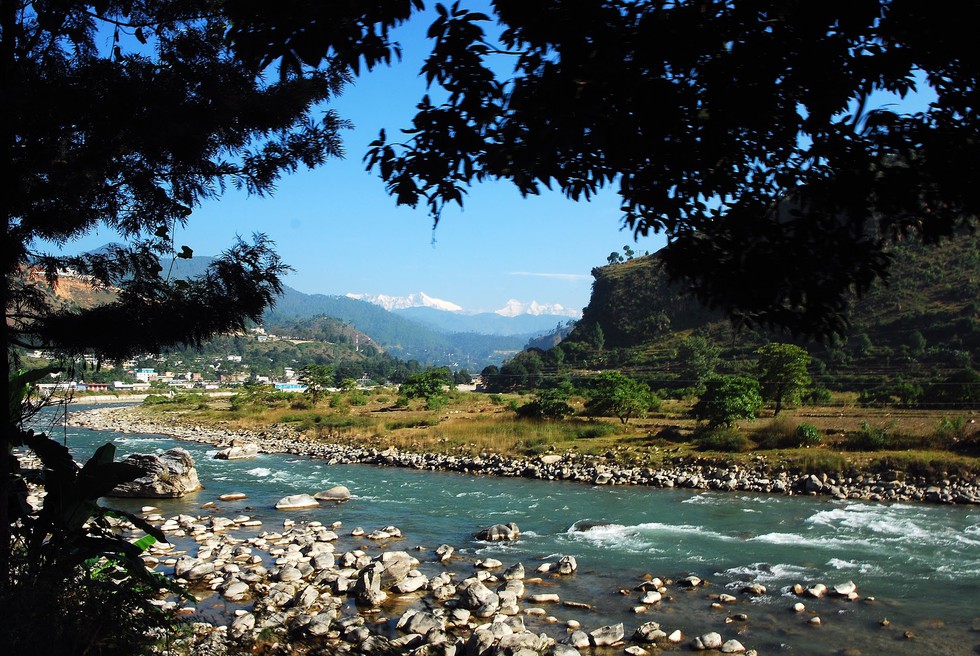
About Saryu River:
- It is a river that flows through the Indian states of Uttarakhand and Uttar Pradesh.
- It is also known as the Sarayu or Sarju River.
- This river is of ancient significance, finding mentions in the Vedas and the Ramayana.
Course:
- It originates primarily from the foothills of the Himalayas and becomes an auxiliary river to the Sharada.
- It flows through Kapkot, Bageshwar and Seraghat towns before discharging into the Sharada River at Pancheshwar at the India-Nepal border.
- Sharada River (also known as Kali River) then flows into the Ghaghara River in Sitapur District, Uttar Pradesh.
- Lower Ghaghara is popularly known as Sarayu in India, especially while it flows through the city of Ayodhya.
- Ayodhya, the birthplace of Lord Rama, is situated on the banks of the river Sarayu.
The banks of Sarayu in Ayodhya are a common site for various religious rituals.
5. Chaukhamba Peak

About Chaukhamba Peak:
- It is a four-pillar-shaped enormous peak located in the northern Indian state of Uttarakhand, west of the Hindu holy town of Badrinath.
- It is a mountain massif that has four summits, along a northeast-southwest trending ridge situated in the Gangotri group of the Garhwal Himalayas.
- Being named as Chaukhamba Peak I, II, III, and IV, all of them have different elevations that lie between 7,138 m and 6,854 m.
- Chaukhamba Peak I remain the tallest of all the four summits, i.e., 7,138 m above sea level.
- It towers above the Gangotri glacier, forming the eastern anchor of the group.
6. MLALAD Fund
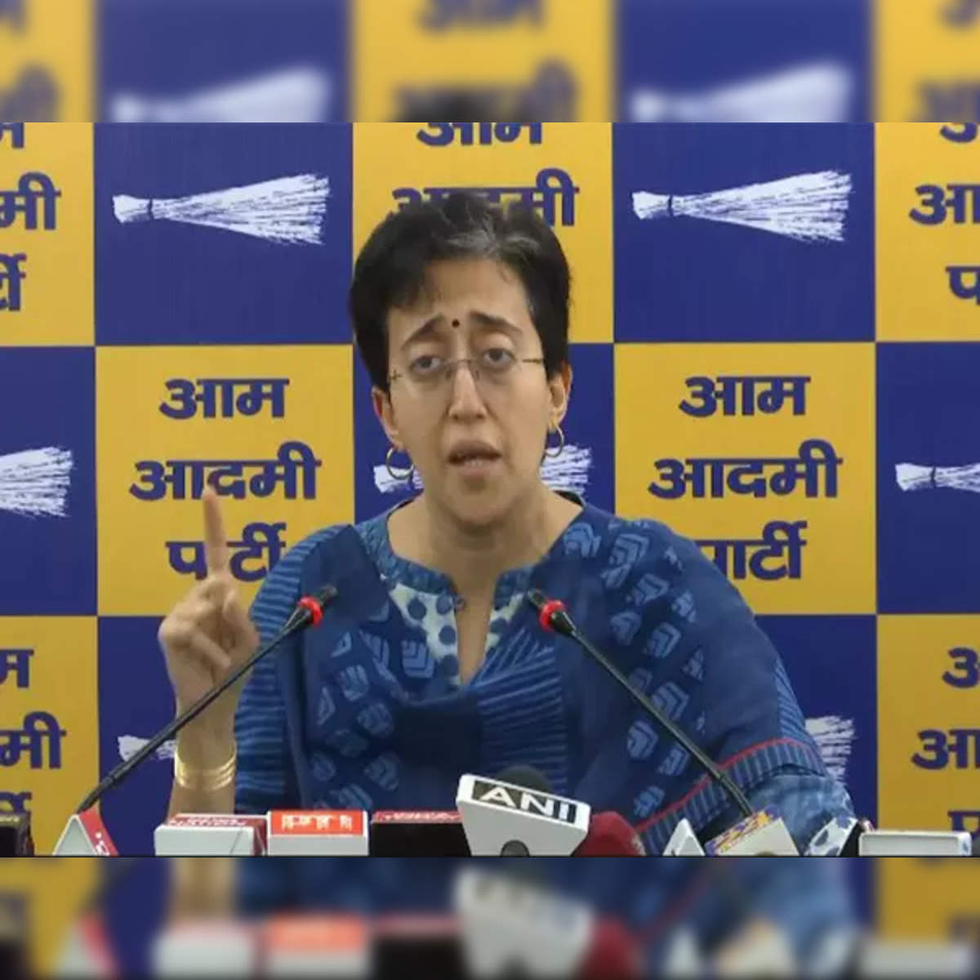
About MLALAD Fund:
- It is modelled on a similar programme for MPs and provides funding for each constituency directly from the government.
- While MLAs and MPs do not directly receive the funds, they can recommend projects for the scheme.
- Both MLALAD and MPLAD have their own sets of guidelines but the projects funded by them are usually restricted to “durable infrastructure work”, from repairing roads to building community centres.
- Under the scheme, each MLA has the choice to suggest to the Deputy Commissioner of his/her district, the extent of allocations given from year to year, to be taken up his/her constituency.
- MLALAD funds are issued every year to MLAs for local development such as repairing roads, and streetlights, developing parks, and laying sewer lines in colonies.
- The type of work under this scheme should be developmental in nature based on local felt.
- The work should be such that it can be completed within one financial year and lead to the creation of durable assets.
- The amount provided under the MLALAD Scheme is released in the form of a Grant-in-aid for utilisation by the districts.
7. Anaconda strategy

About Anaconda strategy:
- It refers to a military strategy with the primary objective of suffocating the Confederacy economically and militarily, similar to how an anaconda snake coils around and asphyxiates its prey.
- It was proposed by Union General Winfield Scott during the early stages of the American Civil War.
- China's 'anaconda strategy’ against Taiwan reportedly involves a mix of military maneuvers, psychological tactics, and cyber warfare to eventually weaken Taiwan's defenses. The ultimate goal appears to be to force Taiwan into submission without engaging in a full-scale invasion.
- China is encircling Taiwan by both sea and air, increasing the number of air incursions to the Taiwan Strait, and employing its ships to operate around the country in what appears to be an effort to tire out Taiwan’s navy and air force.
- It could be the prelude to a more violent showdown in the future.
8. Brahmi Inscription
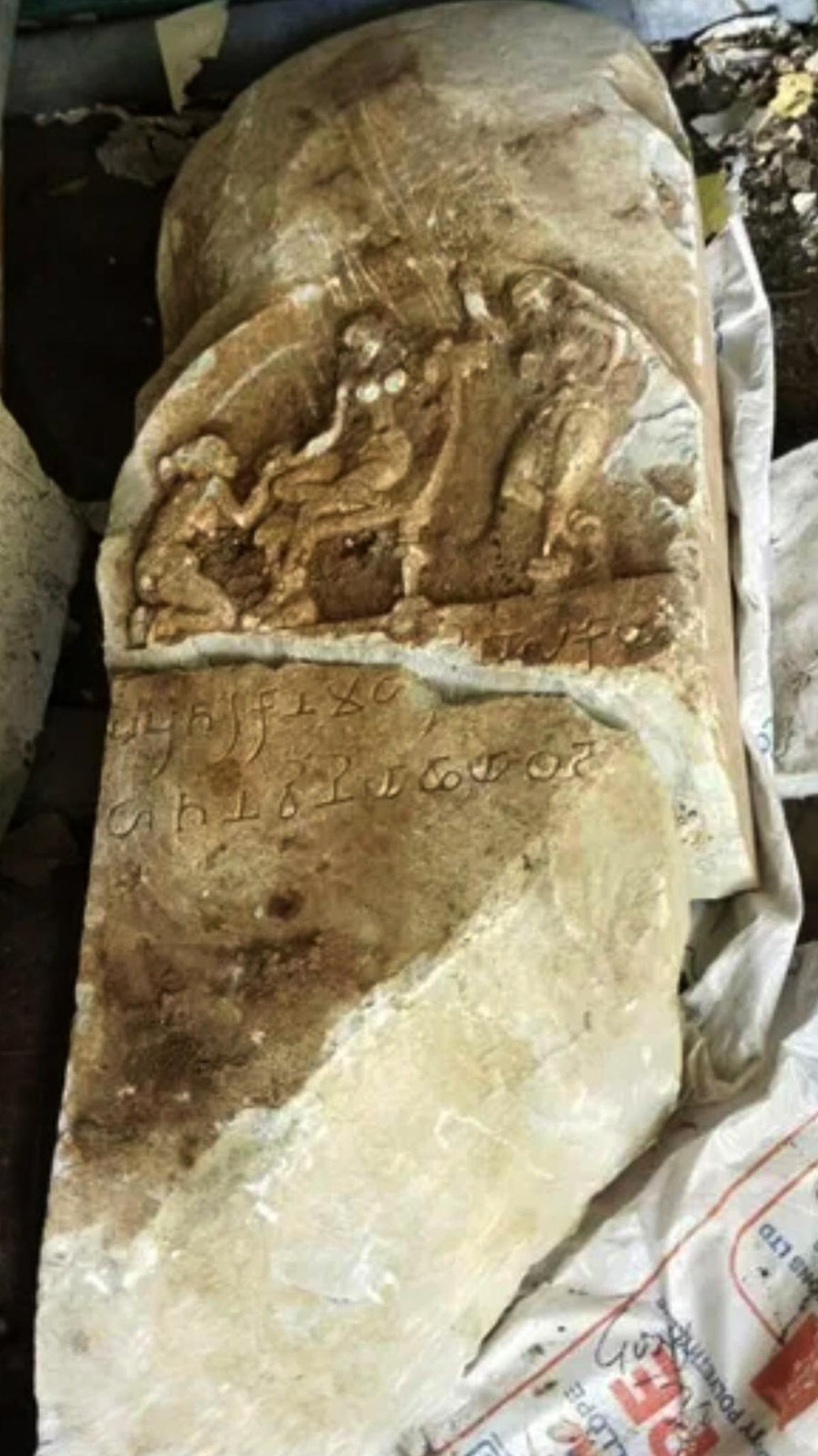
About Brahmi Inscription:
- The Brahmi script is the earliest writing system developed in India after the Indus script.
- It is one of the most influential writing systems; all modern Indian scripts and several hundred scripts found in Southeast and East Asia are derived from Brahmi.
- Most examples of Brahmi found in North and Central India represent the Prakrit language.
- The earliest known Brahmi inscriptions are from the edicts of Ashoka, the third Mauryan emperor of Magadha who ruled most of the sub-continent between 268 and 232 BCE.
- Traces of the script have been discovered not just in the Gangetic plains but also in excavated sites in Tamil Nadu, Kerala and Sri Lanka, mostly on pottery shards.
- Among the many descendant scripts of Brahmi are those of the Indo-Gangetic Plain, such as Devanagari and the Bengali and Gujarati scripts; those of the Deccan region, including the scripts for Tamil, Telugu, Malayalam and Kannada.
9. AstroSat

About AstroSat:
- It is India’s first dedicated multi-wavelength space observatory aimed at studying celestial sources in X-ray, optical, and UV spectral bands simultaneously.
- It was launched by the Indian launch vehicle PSLV from Satish Dhawan Space Centre, Sriharikota, on September 28, 2015.
- The spacecraft control center at Mission Operations Complex (MOX) of ISRO Telemetry, Tracking and Command Network (ISTRAC), Bengaluru, manages the satellite during its entire mission life.
- The minimum useful life of the AstroSat mission is around 5 years.
- It carries a total of five scientific payloads enabling imaging and studying the temporal and spectral properties of galactic and extra-galactic cosmic sources in a wide range of wavelengths on a common platform.
Objectives:
- To understand high energy processes in binary star systems containing neutron stars and black holes.
- Estimate magnetic fields of neutron stars.
- Study star birth regions and high energy processes in star systems lying beyond our galaxy.
- Detect new briefly bright X-ray sources in the sky.
- Perform a limited deep-field survey of the Universe in the Ultraviolet region.
10. Horseshoe crab
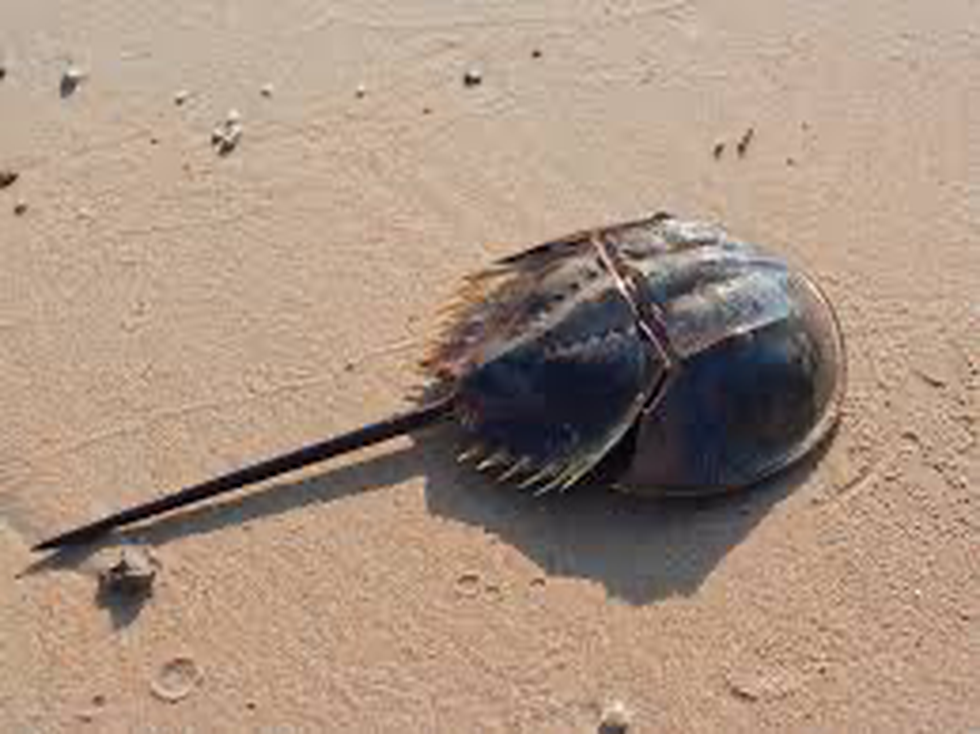
About Horseshoe crab:
- It belongs to a class called Merostomata, living fossils, or those organisms that haven’t changed in millennia.
- It is a marine chelicerate arthropod. The Chelicerata is a division within the Arthropoda, containing animals such as spiders, scorpions, harvestmen, mites and ticks.
- Like all arthropods, they have a segmented body and segmented limbs and a thick chitinous cuticle called an exoskeleton.
- Habitat: They are living in shallow coastal waters on soft sandy or muddy bottoms and spawn mostly on intertidal beaches at summer-spring high tides.
- There are four extant horseshoe crab species:
- The American horseshoe crab (Limulus polyphemus) along the eastern coast of the USA and in the Gulf of Mexico,
- The tri-spine horseshoe crab (Tachypleus tridentatus),
- The coastal horseshoe crab (Tachypleus gigas)
- The mangrove horseshoe crab (Carcinoscorpius rotundicauda)
- The last three are Indo-Pacific species found mainly in the coastal waters of India, Southeast Asia, China and Japan.
- In India, Odisha is the largest habitat of horseshoe crabs.
Conservation status in India
- Wildlife Protection Act 1972: Schedule IV
IUCN Status
- American horseshoe crab: Vulnerable
- Tri-spine horseshoe crab: Endangered
- The two other species are not listed yet


























































































































































.png)
.png)
.png)
.png)
.png)


.png)
.png)
.png)





.png)
.png)






.png)
.png)
.png)
.png)
.png)
.png)
.png)
.png)
.png)

.png)







.png)
.png)


.png)
.png)
.png)


.png)

.png)
.png)





.jpg)

.png)
.png)


.png)

.png)
.png)
.png)

.jpg)

.jpg)


.png)

.png)
.png)
.png)
.png)
.png)
.png)
.png)
.png)
.png)
.png)




.png)

.png)





.png)
.png)
.png)
.png)
.png)
.png)
.png)
.png)
.png)
.png)
.jpg)
.jpg)

.png)
.png)
.png)
.png)
.png)
.png)
.png)
.png)
.png)
.png)
.png)
.png)
.png)
.png)
.png)
.png)
.png)
.png)
.png)
.png)
.png)
.png)



.png)
.png)

.jpg)
.jpg)


.jpg)
.jpg)
.jpg)
.jpg)
.jpg)

.jpg)








.jpg)
.jpg)
.jpg)
.jpg)
.jpg)

















.jpg)
.jpg)







.jpg)


















.jpg)
.jpg)






























































































.jpg)
.jpg)


























.jpg)

.jpg)










.jpg)








.jpg)




.jpg)










.jpg)


















.jpg)












































.jpg)














.jpg)
.jpg)
.jpg)





.jpg)

.jpg)
.jpg)





































































.jpg)


































.jpg)
.jpg)
















































.jpg)












.jpg)


.jpg)




.jpg)
.jpg)
.jpg)

.jpg)
.jpg)
.jpg)
.jpg)

.jpg)
.jpg)
.jpg)

.jpg)
.jpg)
.jpg)
.jpg)
.jpg)
.jpg)
.jpg)
.jpg)

.jpg)


.jpg)
.jpg)
.jpg)
.jpg)
.jpg)
.jpg)
.jpg)
.jpg)
.jpg)
.jpg)











.jpg)
.jpg)





.jpg)
.jpg)
.jpg)
























.jpg)
























.jpg)









.jpg)
.jpg)







.jpg)
.jpg)









































.jpg)
.jpg)
.jpg)
.jpg)
.jpg)

.jpg)
.jpg)
.jpg)
.jpg)
.jpg)


.jpg)
.jpg)
.jpg)
.jpg)
.jpg)

.jpg)
.jpg)
.jpg)
.jpg)
.jpg)
.jpg)
.jpg)
.jpg)
.jpg)
.jpg)
.png)

.png)
.png)

.png)
.png)
.png)
.png)


.jpg)
.jpg)

.jpg)
.jpg)
.jpg)

.png)
.png)
.png)
.png)
.png)
.png)
.png)

.png)
.png)
.png)
.png)
.png)
.png)
.png)
.png)
.png)
.png)





































































-min.png)



.png)




.png)








































